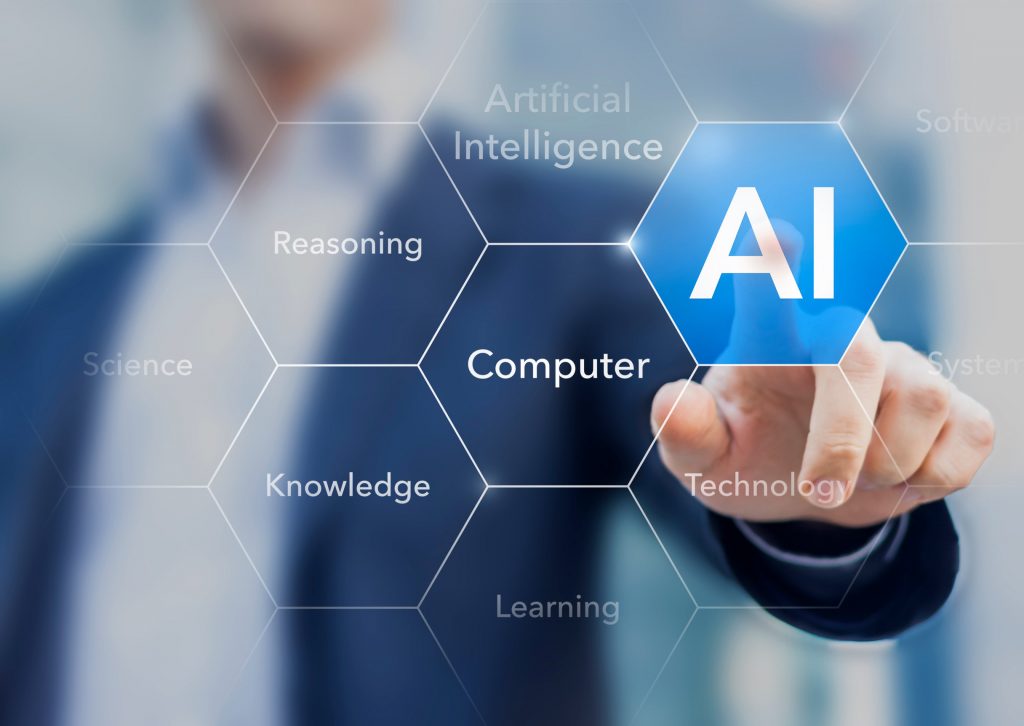Solving complex logistics problems with the help of artificial intelligence (AI)

Artificial intelligence (AI) and combinatorial optimization can and will enrich logistics by enabling predictability and transparency. But in many companies there are still many unanswered questions when it comes to artificial intelligence (AI): In which areas is the use of AI already worthwhile today? What basis do I have to create in my company? And last but not least, the question: What specific benefits does AI bring in logistics?
Cognitive systems based on AI have the ability to learn, recognize patterns and derive recommendations for action or initiate processes themselves. As a result, it is possible for them to support the employees in the warehouse in making decisions or to inform them in advance of likely occurrences. And it is precisely from these abilities – namely the supporting function of AI – that the logistics industry can already benefit. Because the requirements have never been so high. In almost no other industry is the pressure of competition and time so great. Customer expectations are increasing. Delivery delays or errors will not be tolerated. This is where the issue of data quality comes into play: Inadequate article master data, for example, can lead to incorrect deliveries, which in turn has an impact on customer satisfaction. Today, enormous expert knowledge is required to control the supply chain and continuously optimize processes. However, this is often only distributed among individual people, so that it is not always available to employees, for example during vacation or illness of a supervisor. In due course of this short article we would like to present a few case studies from our practice that show how AI can support and solve logistical problems.

Case study 1: Automated dispatching, introductory example
This video shows the general dispatch problem of automated dispatching. The input for the algorithms consists of:
- The network. I.e. the graph of railway connections and nodes.
- The position of each train. I.e. the start node of each train.
- The destination node for each train. Here each train wants to travel to the node with the same colored flag as the train has.
- max possible speed for each train on each rail track.
The conditions modeled here are:
- At any time there may be at most one train on each track.
- At any time no two trains are allowed to travel towards the same node.
The objective is to route each train with timetable so as to fulfill above conditions and so as to minimize the total time needed for the trains to arrive at their respective destinations. Note: The initial picture of the video visualizes a great amount of the input information to the algorithm. The movie with the moving trains then visualizes the result calculated by the algorithm. The algorithm is able to model many more conditions that are relevant in railway dispatching. For instance, overlap conditions, speed differential conditions, capacity on group of rail tracks, ….
Case study 2: Euro tunnel, two sections blocked
This video shows the result of the automatized dispatching algorithm for the tunnel between France and England for a 4 hour period. Usually there is one-way traffic in the tunnel. To make it more interesting
two sections of the tunnel are blocked. All trains in both directions must be scheduled so as to fit through the tunnel. Shuttle, freight and intercity trains are visualized with different colors. Note that the visualization is distorted: The tunnel part in reality is much longer (40 km) than the station parts on the French and English sides.
Case study 3: Automated dispatching for a shunting problem
This video shows the result of the automated dispatching algorithm applied to a shunting problem. The red trains want to go to the red flag, the blue trains to the blue flag. Their initial position is intertwined. The trains are locomotives that can change their direction anytime. At any time at most one locomotive may be on a track. Note that the algorithm comes up with a solution where only two trains are routed along the long upper path. A human (unless a genius) would not come up with such a nice solution.
Case study 4: Chessboard train network dispatching problem with 80 trains
This is an artificial chessboard-like railway network. 80 trains need to be dispatched. Each train has a fixed start and destination point which is input to the dispatching algorithm. The conditions modeled here are:
- On each track there can be at most one train at any time.
- On diagonals in the same square there must be at most one train at any time.
- At any time there must not be two trains moving towards the same node.
- A train is only allowed to take a turn strictly less than 90 degrees.
The aim of the algorithm is to minimize the sum of the delay times over all trains. Note that this is an artificially made difficult problem because many trains have to move on a small network. The denser the traffic the more difficult is the dispatching problem. This is a hard combinatorial problem. It is solved by splitting the area in subareas. But this is not easy to do because also along the borders of the subareas it must be made sure that the conditions above are fulfilled. However, this approach allows the parallelization of the computation.
Case study 5: Automated air traffic dispatching
This video shows an air traffic control dispatching problem. Each plane has a fixed entry point and entry time into the network and also a fixed destination exit point. There are three flight levels: a red, a green and a blue flight level. Whenever a plane changes the flight level it changes its color. I.e. the network is a stacked chessboard-like network with 3 levels. The modeled conditions are:
- Inside one air cube there must be at most one plane at any time. However, on opposite sides of an air cube there can be two planes, one plane on each side.
- No two planes can fly towards the same node at any time.
- planes are not allowed to fly sharp turns. I.e. in planar and vertical direction only a simple (45 degrees like in the video) turn is allowed. I.e. when two planes cross each others route they must be on different flight levels.
Digitization of the supply chain is the basis for all AI initiatives
The basis for the use of AI-supported systems is the digitization of business processes. Many companies have already recognized the opportunity and have begun to interconnect all participants and systems in the supply chain with one another in order to meet the increasing requirements. This means that all relevant data of the supply chain are transparently available. The use of AI promises a smart use of data and thus an increase in efficiency. In short: the integration of AI takes logistics to a new level. There are many areas of application within the supply chain in which AI efficiently supports employees – not as a replacement of resources – but as an assistance system.
Related links
Artificial Intelligence and Machine Learning in the Insurance Sector
Predictive Maintenance in Aerospace – Innovative Use Cases
Trends in Data-Driven Internet of Things (IoT)
Das Potenzial von Daten durch Business Analytics voll ausschöpfen!
How to approach Business Analytics? A guide for better insights out of big data
The ROI of a Modern Data Strategy
Fachkompetenz Business Analytics
About us
Our positioning and mission statement: “Mastering the Digital Age!” We are an integrated management and technology consulting group and offer the conception and implementation of holistic digitization solutions in an integrated manner. In combination, you will receive strategic advice from us on the digitization of your company from real thought leaders with profound methodological knowledge, extensive transformation experience from successful IT system integrators with many years of industry experience and a high level of technological understanding, as well as deep expertise in generating value from data – the new gold of the 21st century – with the help of the latest artificial intelligence (AI) and cloud computing technologies. All this End2End from a single source for the entire transformation process! Find out more about us here.
Did we spark your interest?
Are you facing similar challenges in your company? Do you have any questions about the case study described? If you are interested in an in-depth discussion, then write us an email or give us a call. We would be happy to present our consulting products and digital solutions to you in a personal discussion. We are looking forward to meet you!

Dr. Erich Steiner
Partner, Business Analytics / Artificial Intelligence / Big Data Practice
Strategy & Transformation Consulting
Email senden

Kommentare geschlossen